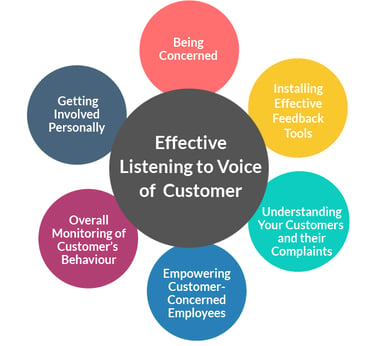Once you have established that customer service is paramount to successfully running your service business, the obvious next step is to devise systems and procedures that can help you effectively learn, combat and manage customer grievances and any shortfalls in service levels from customer expectations.
This is a complex process, though not overly so, and can be succinctly summarised in the following points:

Being concerned
The very first step is to view each customer as a potential detractor, and thus being concerned about any untoward reviews from them. Studies have shown that a single negative review can offset 12 positive reviews. This puts an ever greater pressure on management and support staff to be actively involved with each and every customer, so that no customer leaves disgruntled. The caveat here is that being concerned alone won’t solve the problem, unless supplemented with the following actions.
Installing effective feedback tools
An effective listening to voice of customers would work only when effective tools to collect feedback are in place. While the definition of ‘efficiency’ in the context of feedback collection tools may be subjective, there are three things that any feedback collection mechanism must provide for it to be deemed worthy of consideration:
- Ability to capture vast amount of data - Only an innovative and unconventional feedback collection method will excite customers to leave their feedback.
- Ability to manage all collected data - A massive amount of data is meaningless if not stored in a format conducive to drawing business insights and trends of customer behaviour.
Ability to allow immediate addressal of customer grievances
As important as it is to store and record trends of customer behaviour, it is equally essential to solve service-related issues that customers may have, while they are still on-premises as this can eliminate the possibility of a customer venting their dissatisfaction online. A study has gone so far as to report that 82% of customers say that the most important factor leading to a great customer experience is having their issues resolved quickly.
Given that a manager’s focus is on effectively listening to his customers, a logical conclusion would be the installation of a strong and reliable feedback collection procedure.
Understanding your customers and their complaints
This is basically a continuation of the definition of an effective feedback collection system, but merits a separate mention. Immediate addressal of customer complaints becomes feasible only with a thorough knowledge of what the exact issue is and where the grievance has arisen from. Gaps in service quality can be plugged in only with an in-depth understanding of why and how the lapse in service occurred in the first place. Complete data capturing of customers can help in a more robust loyalty module allowing personalized service to regular patrons.
This points to the development of a process that naturally tends towards a “systematic listening” and address of customer grievances.
Empowering customer-concerned employees
With the installation of a sound feedback collection system, comes the added responsibility of delegating responsibilities appropriately to the front-line, customer facing staff members. Doing so will ensure that all customer grievances are handled in a timely and accurate fashion.
An effective feedback collection tool, should, therefore, provide a means for assigning tasks to staff members, particularly the customer-centric staff. It would be even better if this mechanism could work in real-time, thereby resolving customer complaints quickly and ensuring cent per cent customer satisfaction.
Overall monitoring of customer’s behaviour
With on-premise resolution of customer grievances taken care of, the real value of a customer feedback system can be extracted from its ability to track trends in customer satisfaction and behaviour over time.
Customers rate a business over several parameters – pricing, service quality, attitude of staff while interacting with customers to name a few. Their overall satisfaction of interacting with the business will then, not be limited to just the quality of service provided but will depend on a delicate balance of these parameters, based on what weight they assign to each of them. An important thing to note is that these preferences may change over time and vary across customer segments. In an effort to keep all customers equally satisfied over time, these changes must be carefully measured and appropriate actions taken.
An effective feedback system will allow business managers to understand their customers changing preferences and make business decisions in accordance with those changes. This will truly include the customer’s voice in implementing business strategies.
Getting involved personally
Last but certainly not the least, nothing makes a customer’s day more than the pleasure of having his issue resolved instantly, and that too with the knowledge that their servers took a “personal” interest in their service. Establishing a personal connection with customers is becoming a vitally important aspect of service-oriented businesses.
Therefore, merely assigning customer complaints to staff members may no longer help the business acquire and retain customers, but taking a “personal” interest in the resolution of their customer’s issues will. Since this personal connection will help the customers achieve a sense of belongingness with the business and there will then be a higher likelihood of them returning again and again.
An effective methodology to listen to customer’s voice, then, remains incomplete without a mechanism to getting involved personally with the customers.
Managing a business that does not sell tangible goods but intangible service can be tricky, but a task that can be accomplished if the basics are done right – listen to what the customers are saying, respond effectively and analyse their feedback to make sure things don’t go wrong again.
 Integrations
Integrations







-min-1.png)
.jpg)
.jpg)
-1.png)
.jpg)

















